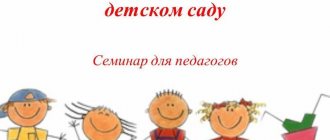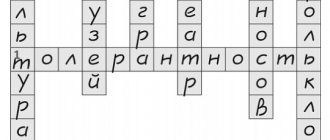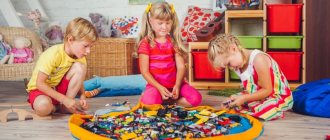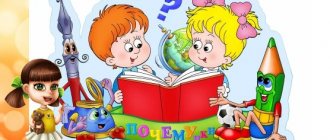“Formation of a favorable psychological climate in the preschool educational institution team” Psychological training
Author - compiler:
Kaverzina Diana Rinatovna
educational psychologist
MADOU "Combined Kindergarten No. 1" in Tobolsk
Psychological training:
“Formation of a favorable psychological climate in the preschool educational institution team”
Purpose of the training :
- unity of the teaching staff , development of communication skills, emotional stability, self-confidence, friendly attitude towards each other.
Participants: teaching staff of the preschool educational institution.
Time: 1 hour.
Training objectives:
— creating a favorable psychological climate;
— finding similarities among group members to improve interaction between them;
— developing the ability to work in a team;
- team building;
- increase your mood for luck, happiness, kindness and success.
Equipment: a sheet of Whatman paper, colored cardboard figures (triangles, circles, rectangles, squares, zigzags; A-4 sheets according to the number of participants, pencils, felt-tip pens, colored pencils, ballpoint pens according to the number of participants; cut out from red, yellow, green paper leaves, wood model, glue.
Progress of the training
Teacher - psychologist : Good afternoon! I am glad to welcome you to our training! It’s wonderful that we were able to meet with you and have the opportunity to relax a little, rest, play, learn something new about ourselves and our colleagues and , most importantly, express the joy of meeting each other.
Today I would like to talk to you about the psychological climate of the team , as well as the importance of team .
Before moving on to the concept of psychological climate in a team, let’s define what a “team” is?
Exercise “Associations to the word collective”, “What does collective mean to me?”
And indeed, for each of us the team has a certain meaning. So, a collective is a type of social community and a set of individuals who interact with each other in a certain way, are aware of their belonging to a given community and are recognized as its members from the point of view of others.
Psychological climate is , as you know, interpersonal relationships typical of the work collective , which determine its basic mood.
in one climate , but wither in another. The same can be said about the psychological climate of the teaching staff of a preschool educational institution: in some conditions, teachers feel uncomfortable, tend to leave the team , spend less time in it, their personal growth slows down, in others - the team functions optimally and its members get the opportunity to maximize realize your full potential (which is what we strive for).
Creating emotional well-being in the teaching staff team cohesion is the most important task not only for the administration, but also for each member of the team .
The psychological climate is called favorable if an atmosphere of goodwill, care for everyone, trust and mutual understanding reigns in the team . If team members are ready to work , show creativity and achieve high quality, working without control and taking responsibility for the work. If everyone in a team is protected , feels involved in everything that is happening and actively engages in communication.
Exercise "Greetings"
Purpose of the exercise: to determine the purpose of a smile as a means of conveying a message.
Task: greeting your communication partner with a smile
Instructions: today, instead of saying “hello,” we will greet each other with a smile. You are given the right to choose different smile options: sincere, arrogant, ironic, insincere.
Exercise Analysis:
1. By what signs did you guess that the smile is sincere, ironic, arrogant?
2. How did you feel when you received a smile instead of a greeting?
3. How often and in what situations do you usually use a smile to establish contact?
Exercise “Swap places those who...”
Goal: getting back into work, relieving accumulated stress.
Group members sit on chairs in a circle. The driver stands in the middle of the circle. He says: “Those who have two children, change places”; “Swap places, those who have
senior groups"; “Change places, those who love ice cream”; “Change places, those in dresses”; “Change places those who sing well,” etc.
We have learned a lot about each other, and with the next exercise I want to see how attentive you are to each other.
Exercise “Be Attentive”
Purpose of the exercise: to develop the participants’ attentiveness to each other.
Psychologist : “When talking, people look at each other. To test your powers of observation, let's play. Close your eyes. Now raise your hand, who has a neighbor with blond hair? Open your eyes and check yourself. Close your eyes again. Who has a neighbor with dark eyes? Raise a hand. Open your eyes and check yourself. Close your eyes again. Who has a neighbor who has two holes in his ears? Raise a hand. Open your eyes and check yourself."
Exercise "Confusion"
The purpose of the exercise: to increase the tone of the group and unite the participants.
Psychologist : “In this game we will all try to improve each other’s mood.
Everyone stands in a circle and raises their right hand. Now you need to take the hand of any of the participants, except your neighbor. Without unclenching your right hands, repeat the same with your left. Now everyone is tangled up in a ball. We need to untangle the tangle by holding hands.
Exercise “Compliment”
Purpose of the exercise: creating a positive emotional attitude towards the interlocutor, mastering the technique of complimenting.
Assignment: come up with a compliment that matches the personal qualities of the interlocutor.
Instructions: the psychologist recites lines from the poem:
“Let's exclaim, admire each other,
There is no need to be afraid of high-flown words.
Let's compliment each other
After all, these are all happy moments of love!
Today we will compliment each other. Choose a partner to complete the task. The exchange of compliments will take place in the form of dialogue . It is necessary not only to receive a compliment, but also to return it.
For example:
- Tom, you are such a sympathetic person!
- Yes it is! And also, I'm kind!
-And you, Sveta, have such beautiful eyes!
A compliment is accepted in a certain form : Yes, it is! And also I (a positive quality is added) and the compliment is returned to the speaker.
Exercise Analysis:
1. What difficulties did you encounter while performing this exercise?
2. Were there any pleasant moments in the exercise, what were they?
Exercise “Tree of achievements of our team”
(Based on the exercise “Tree of Achievement” by M.E. Zimireva)
This exercise promotes the development of reflective self-awareness and develops the ability to collaborate. The goal of this seminar is to see the achievements of individual teachers in the unity of the entire team.
In front of you are leaves of three colors. If you think that you have achieved success in your professional activities, in your work, stick a green leaf on the “tree”. If you have learned to communicate successfully with each other – red. If you have achieved personal success - yellow. Discussion: which leaves are more on our tree, what has our team achieved?
Unity game (based on the metaphor game “Mandala”).
Purpose of the game: team building.
I suggest you rest a little and play. Here are figures of different shapes and different colors. Choose any of them you like. Now draw on it with a pen something that you would like and would give pleasure. It could be some kind of pattern, flower, sun, etc. And now from all the figures you need to put together one common figure that would unite us all as a collective. (Discussion, gluing figures onto whatman paper). Now let's see what we got. This common figure is an expression of the soul of our collective, in which there is a piece of each of us and all of us together. Each has its own meaning and place in this colorful harmonious composition. Look how many different elements there are. Find your figurine. Notice how each figure is close to each other. If you remove at least one of them, the whole composition will be disrupted. Each of us is a part of the team and each of us has a worthy place in it.
The game can be used for diagnostic purposes. The interpretation of the selected figures and colors is carried out according to the psychogeometric test and the Luscher color test in the form of a psychological consultation, taking into account the presence of listeners.
Summarizing
To summarize, I would like to quote the words of A.S. Makarenko, who said: “The team of teachers, educators and the team of children are not two teams, but one team and, moreover, a pedagogical team.” The collective has been called "the most powerful weapon known to man." It has the potential to be a powerful stimulant, encouragement and inspiration.
Photo for memory
All seminar participants form a single “sculpture” and take photographs.
Bibliography:
1. Magazine “Child in kindergarten”
2. Prutchenkov A.S. Social-psychological training/A.S. Prutchenkov.-2nd ed. Additional and reworked - 2003
- https://trepsy.net/
“Certificate of publication in the media” Series A No. 0004415
We invite teachers of preschool education in the Tyumen region, Yamal-Nenets Autonomous Okrug and Khanty-Mansi Autonomous Okrug-Yugra to publish their teaching materials: - Pedagogical experience, original programs, teaching aids, presentations for classes, electronic games; — Personally developed notes and scenarios of educational activities, projects, master classes (including videos), forms of work with families and teachers.
Why is it profitable to publish with us?
1. “Kindergartens of the Tyumen Region” is an officially registered specialized media outlet at the federal level. 2. The activities of the editorial office are supported by the Department of Education and Science of the Tyumen Region 3. We issue a “Certificate of Publication” in the media. 4. The document has a unique number, is entered in the register, has the original seal of the editorial office of the online publication and signature. 5. “Certificate of publication” in the media is sent to the author in both paper and electronic versions.
Details >>>
Sample “Certificate of publication of author’s methodological material in the media.”pdf
Share
Training for preschool educational institutions to develop cohesion.
Training for preschool educational institutions to develop cohesion.
Training for preschool educational institutions to develop cohesion.
Training for preschool educational institutions to develop cohesion. I work in a kindergarten as a teacher and part-time psychologist. At one of the teachers’ meetings, I decided to conduct a training; I didn’t even expect that it would turn out so great. The participants really liked it and received a lot of positive feedback.
Goal: Uniting the teaching staff, building effective team interaction.
Tasks:
1. Formation of a positive psychological climate in the teaching staff, relieving psycho-emotional stress.
2. Overcoming psychological barriers, developing a trusting relationship in the group.
3. Participants’ awareness of their role in the group, development of the ability to work in a team.
4. Uniting the teaching staff.
To conduct the training, it is necessary to adopt group norms:
The rule of confidentiality is that everything that is said and heard in the group is not carried outside of it. You can only tell third parties your feelings and experiences; you cannot talk about the feelings of other people.
-speak sincerely
- adhere to the “here and now” principle.
Progress of the lesson:
Game “Name-epithet” (relieving tension, getting ready to work, removing barriers).
It is suggested that you choose an adjective epithet for yourself that begins with the initial letter of your name. This epithet should describe the person in a positive way and, if possible, contain exaggeration. (Charming Olesya, Wild Bella). Each participant must introduce themselves and say hello in an original way.
Exercise “Joint counting”.
Instructions “You should only count to. (number of participants) “The essence and trick of the task is that you need to count collectively, that is, one person says something, the next person says two, without agreeing on the order (spontaneous counting). If two participants name the number, the exercise starts again. There are two versions: with open eyes and closed.
Exercise “The uniqueness of everyone.”
Instructions “In front of you is a piece of paper and a pencil. Write what makes you unique. Try to include unexpected facts. Don't show your leaves. I'm collecting the leaves and we'll try to determine who each one belongs to. "
Exercise “Tower of Babel”.
Instructions: “Divide into two teams. Each member will have his own task, which I will give. You will need to draw a picture together, but you should not communicate with each other. Draw 8 floors on the tower, Color the tower green. Draw 16 windows. "
Exercise "Carriage".
Instructions: “You need to depict a carriage. You are its parts, without foreign objects.”




